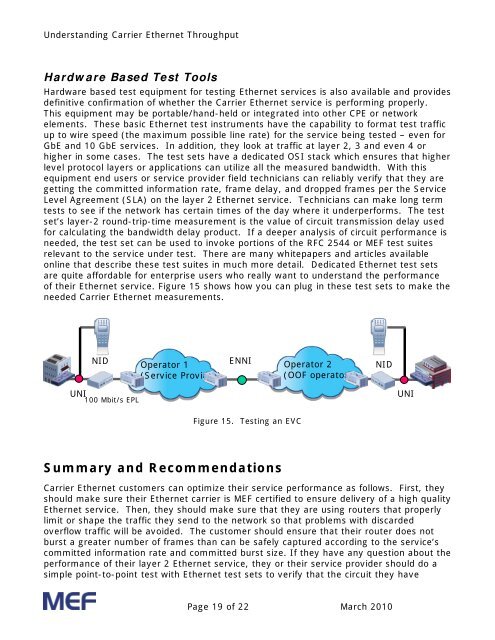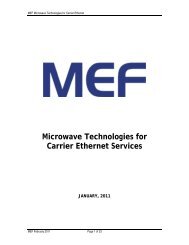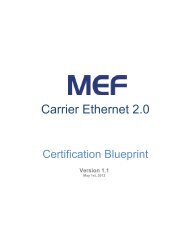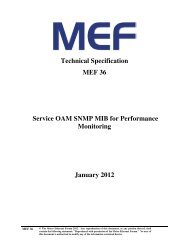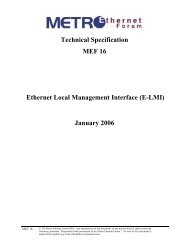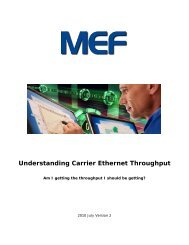Understanding Carrier Ethernet Throughput - MEF
Understanding Carrier Ethernet Throughput - MEF
Understanding Carrier Ethernet Throughput - MEF
You also want an ePaper? Increase the reach of your titles
YUMPU automatically turns print PDFs into web optimized ePapers that Google loves.
<strong>Understanding</strong> <strong>Carrier</strong> <strong>Ethernet</strong> <strong>Throughput</strong>Hardware Based Test ToolsHardware based test equipment for testing <strong>Ethernet</strong> services is also available and providesdefinitive confirmation of whether the <strong>Carrier</strong> <strong>Ethernet</strong> service is performing properly.This equipment may be portable/hand-held or integrated into other CPE or networkelements. These basic <strong>Ethernet</strong> test instruments have the capability to format test trafficup to wire speed (the maximum possible line rate) for the service being tested – even forGbE and 10 GbE services. In addition, they look at traffic at layer 2, 3 and even 4 orhigher in some cases. The test sets have a dedicated OSI stack which ensures that higherlevel protocol layers or applications can utilize all the measured bandwidth. With thisequipment end users or service provider field technicians can reliably verify that they aregetting the committed information rate, frame delay, and dropped frames per the ServiceLevel Agreement (SLA) on the layer 2 <strong>Ethernet</strong> service. Technicians can make long termtests to see if the network has certain times of the day where it underperforms. The testset’s layer-2 round-trip-time measurement is the value of circuit transmission delay usedfor calculating the bandwidth delay product. If a deeper analysis of circuit performance isneeded, the test set can be used to invoke portions of the RFC 2544 or <strong>MEF</strong> test suitesrelevant to the service under test. There are many whitepapers and articles availableonline that describe these test suites in much more detail. Dedicated <strong>Ethernet</strong> test setsare quite affordable for enterprise users who really want to understand the performanceof their <strong>Ethernet</strong> service. Figure 15 shows how you can plug in these test sets to make theneeded <strong>Carrier</strong> <strong>Ethernet</strong> measurements.NIDOperator 1ENNIOperator 2(Service Provider)(OOF operator)NIDUNI100 Mbit/s EPLUNIFigure 15. Testing an EVCSummary and Recommendations<strong>Carrier</strong> <strong>Ethernet</strong> customers can optimize their service performance as follows. First, theyshould make sure their <strong>Ethernet</strong> carrier is <strong>MEF</strong> certified to ensure delivery of a high quality<strong>Ethernet</strong> service. Then, they should make sure that they are using routers that properlylimit or shape the traffic they send to the network so that problems with discardedoverflow traffic will be avoided. The customer should ensure that their router does notburst a greater number of frames than can be safely captured according to the service’scommitted information rate and committed burst size. If they have any question about theperformance of their layer 2 <strong>Ethernet</strong> service, they or their service provider should do asimple point-to-point test with <strong>Ethernet</strong> test sets to verify that the circuit they havePage 19 of 22 March 2010


